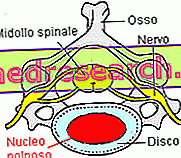Generality
Fracture of the hip is a serious injury that occurs mainly in older people. Often, this pathological event is the consequence of a trivial fall to the ground, but it can also depend on direct impacts, road accidents and sports injuries .

Usually, the rupture affects the proximal part of the femur (femoral neck), which connects the main bone of the leg to the hip, in the coxo-femoral joint .
The hip fracture typically occurs with a violent pain at the point where the rupture occurred, at the level of the external thigh or groin, with deformation of the limb and difficulty moving the leg . Following the trauma, it is possible that the limb assumes an unusual appearance or position (there may be a twist, an angle or a shortening of the limb itself). Subsequently, swelling and ecchymoses may appear.
To make a reliable diagnosis of a hip fracture, the patient undergoes an X-ray .
The condition almost always requires an intervention to fix the broken bone, the choice of which is the responsibility of the orthopedic surgeon.
In cases where the hip fracture is particularly disjointed, it is necessary to intervene with the surgical removal of the injured part and place a prosthesis . Subsequently, it is essential to follow a physiotherapy cycle to re-educate the limb on walking.
What's this
A hip fracture consists of partial or total rupture of the upper portion of the thigh bone (femur). This occurrence often results from a trauma, a violent bump or a fall, especially if the subject is suffering from osteoporosis .
Note
The fracture generally occurs in the proximal part of the femur.
This leg bone, in fact, entering the acetabulum, participates in the hip joint (or coxo-femoral).
Therefore, more than a hip fracture, it would be correct to speak of a femoral fracture.
Hip fracture: where does it occur most commonly?
The hip is a very complex articulation, which allows the thigh to flex and rotate within the pelvis.
- Most fractures involve the femoral neck, ie the area immediately below the spherical head, which is inserted into the articular cavity of the pelvis; at this level, fundamental muscles enter the movement.
- In the remaining cases, the intertrochanteric area is involved, along the outer part of the upper extremity of the thigh bone.
Depending on the area where the rupture is located, the hip fracture can also be distinguished in extra-capsular or intra-capsular.
Types of Hip Fracture
The hip can break in several ways.
In particular, the fracture can occur at the level:
- Intra-capsular (inside the joint capsule);
- Extra-capsular (outside the joint capsule).
When the rupture occurs at the point where the femur connects to the hip, ie at the level of the capsule composed of ligament fibers ( intra-capsular hip fracture ), the lesion is more severe. This area is, in fact, highly vascularized, therefore at risk of necrosis of the bone tissue.
The hip fracture can also be:
- Not decomposed : the bone fragments, even if broken, are still aligned in their normal position;
- Decomposed : it is a fracture where the broken bones are displaced from their normal position, so the fragments will have to be realigned and fixed in place.
Causes and Risk Factors

The people most at risk of suffering a hip fracture are the elderly, especially if they suffer from osteoporosis . This disease, in fact, makes the bones fragile and prone to breakage.
The most typical reason is a trivial fall chance. In young patients, hip fractures are frequently associated with road accidents or sports injuries.
What are the causes of the fracture of the hip?
Hip fracture occurs more commonly following:
- Accidental fall : it is responsible for 90% of all hip fractures; it can occur when an elderly person trips on a carpet or a step. In patients suffering from severe osteoporosis, the chances of incurring this injury by falling to the ground, increase dramatically;
- Direct shot to the side of the hip ;
- Sports traumas ;
- Road accidents .
In severe cases, it is possible for an elder to fracture his hip, standing and without falling, simply with a twist or a wrong and excessive load.
In addition to osteoporosis, hip fractures can be favored by other pathological conditions, such as:
- Cancer ;
- Chronic overuse injuries : can weaken the bone and make the hip more susceptible to breakage.
Hip fracture: who is most at risk
The odds for a patient to fracture a hip increase with:
- The sex of the patient : for women, the risk of running into a hip fracture is two to three times greater than that of a man.
- Age : hip fractures can occur at any age, but the odds increase significantly after age 50, to double, every five to six years later, mainly due to the continued weakening of the bones due to osteoporosis .
- The previous and / or concomitant pathological conditions : physical frailty, arthrosis, unstable equilibrium, motor difficulties, altered vision, senility, dementia and / or Alzheimer's disease can increase the risk of falling.
Other factors that can increase the risk of running into a hip fracture are:
- Familial predisposition to osteoporosis, loss of bone mass or fractures;
- Low body weight and poor diet, including a diet low in calcium and vitamin D;
- Lifestyle, such as smoking, excessive alcohol consumption and lack of exercise;
- Taking drugs that affect the central nervous system, affect balance and strength or cause drowsiness and dizziness.
Symptoms and Complications
The hip fracture manifests itself with acute pain at the top of the outer thigh or groin, with deformation of the limb (there may be a twist, an abnormal angle or a shortening of the leg). After the injury, the patient feels a strong discomfort at any attempt to flex or rotate the hip .
In the geriatric setting, the hip fracture represents one of the main health emergencies . About 30% of people over the age of 65 who suffer this injury die after one year from a combination of disorders related to severe disability and loss of autonomy .
What are the symptoms of hip fracture?
Symptoms of hip fracture may vary depending on the site of injury.
Usually, they manifest themselves:
- Violent pain, which increases at the exact point where the hip fracture occurred;
- Inability to move immediately after a fall, trauma or accident;
- Problems with standing and unloading weight on the injured hip;
- Rotation to the outside or to the injured leg;
- Deformation and shortening of the affected limb (if the bone is completely broken).
Subsequently, they can appear:
- Swelling (limb swelling);
- Ecchymoses or bruises.
It should be noted that if the bone was already weakened by a disease (such as in the case of a stress fracture or a tumor), the patient will experience pain in the groin or thigh for a period of time prior to the fracture.
Hip fracture: possible associated complications
Properly managed hip fracture can be associated with complications that include:
- Post-traumatic osteoarthritis;
- Infections;
- Deformity;
- Joint stiffness;
- Limping gait.
The hip fracture also causes many complications related to the sudden absence of autonomy and the need for a long period of hospitalization or bed rest.
These include:
- Venous thrombosis;
- Bedsores;
- Urinary tract infections.
After a hip fracture, many patients are unable to regain their ability to live independently. The psychological aspect of this eventuality should not be underestimated: an elderly person suddenly finds himself being self-sufficient to be sick and deprived of his autonomy.
Diagnosis
Generally, after the hip fracture, the patient or caregiver must call 118, avoiding transportation to the hospital with their own means. Healthcare professionals will provide transportation after appropriately immobilizing the limb in order to relieve pain and reduce the risk of complications.
Warning! The person offering first aid in the event of a fall to the floor with hip pain should behave as if the injured person had a fracture and ran the maximum risk .
The diagnosis of a hip fracture is generally placed by an X-ray . If a partial (incomplete) fracture is not evident with this examination, it is possible to use magnetic resonance or, alternatively, computerized tomography (CT).
Treatment
In most cases, hip fracture requires an immediate operation to repair bone breakage. The choice of surgical treatment depends on the type of reported rupture (intracapsular or extracapsular). In general, the intervention consists in the union of the bone fragments with plates or nails or in the application of a total joint prosthesis or of the femoral extremity only.
After the operation, rehabilitation is important and, in the elderly patient, continuous monitoring of general health, as well as the correct management of osteoporosis.
Hip fracture surgery therapy
In most cases, the subject undergoes surgery within 24 hours of the injury. This approach aims to achieve an early functional recovery.
The technique used depends mainly on the type of fracture and the age of the patient.
If the rupture occurred along the outer part of the upper end of the femur (intertrochanteric area), it is possible to realign the fragmented ends, securing them with an internal fixation . The ideal candidates for this repair operation have strong bones and normal spraying of the injured part.

In internal fixation, the broken ends of the bones are aligned and put back into place with the help of small metal devices.
However, a hip fracture that could hinder or interrupt normal blood supply to the femoral head can lead to avascular necrosis. For this reason, some doctors believe that total or partial replacement of the hip is the best choice, especially if the bones are weakened by osteoporosis.
After the surgery
In some cases, the person is able to stand up the day after the surgery. Other times, it is necessary to fix the fracture with special screws and the limb must not be "loaded" for at least two months.
Treatment outcomes are variable:
- Many subjects recover with a rapid and optimal recovery of their functionality.
- For others, however, the fracture means the loss of mobility and, sometimes, autonomy and impossibility to live at home.
Overall, one year after the pathological event, mortality is high - around 30% - although only a third is directly attributable to the hip fracture.
Rehabilitation from the Fracture of the Hip
After the surgical treatment to repair the hip fracture, it is essential to follow a physiotherapy cycle to re-educate the limb on walking and restore the previous autonomy, compatibly with the general conditions of the person.

The rehabilitation program is gradual and is structured differently according to the type of fracture and the type of surgery.
In general, the objective is to reduce as much as possible the time of lodging, recover the balance and the motor pattern (ie walk with double support, adequately controlling the weight on the operated limb), in order to regain autonomy in everyday life activities.
Prevention
To prevent hip fractures, act to reduce risk factors . These can be divided into two groups, namely those that:
- Reduce bone density (osteoporosis);
- The risk of falling in the elderly increases.
Some factors, such as immobility, act on both these aspects.
The prevention of hip fracture is possible with some simple precautions, valid at any age :
- When carrying out sports activities, it is good to pay attention to the protection of the joints;
- Do not subject the joint to repeated and stressful movements.
To address the problems associated with osteoporosis and reduce the risk of suffering a hip fracture, you should:
- Exercise regular motor activity, such as brisk walking, to maintain good muscle tone and proper coordination of movements at all ages, especially when bone mass is reduced;
- Limit prolonged periods of immobilization as much as possible;
- Avoid postures, activities and exercises that produce high load stress;
- Complete the diet with calcium and vitamin D, in addition to sticking to the drug therapies prescribed by your doctor.
Some behavioral factors negatively affect bone mineral heritage, such as:
- Cigarette smoke;
- Excessive consumption of alcohol.
An important preventive measure consists in identifying or controlling the possible factors responsible for a fall .
In this regard, it is advisable:
- Always use comfortable and closed shoes with non-slip soles;
- Remove all obstacles along the usual routes, inside and outside the house, such as carpets, light and telephone wires or furniture;
- Eliminate chairs and / or armchairs if they are not very stable;
- Integrate domestic environments, such as the bathroom, with useful accessories to ensure support and avoid falls (eg non-slip mats in the shower, handrails near the bathtub, handles and supports next to the toilet or bidet etc.)
- Equip the stairs with a handrail and adequately illuminate the steps (especially the first and the last), possibly also applying anti-slip strips.
- Light up all the rooms well and pay attention if you walk outdoors on slippery surfaces;
- Avoid sudden movements, such as getting up from the chair or from the bed, to avoid dizziness that could cause a fall;
- Have the balance, gait, muscle strength and visual ability evaluated regularly;
- Do not abuse anxiolytics, sleeping pills or other drugs (especially if they act on the central nervous system) to keep the state of vigilance and reaction intact in case of loss of balance. Eventually, it is possible to have the doctor periodically evaluate the pharmacological prescription in subjects at risk, to remodel it, if possible, and reduce the risk of falling.



